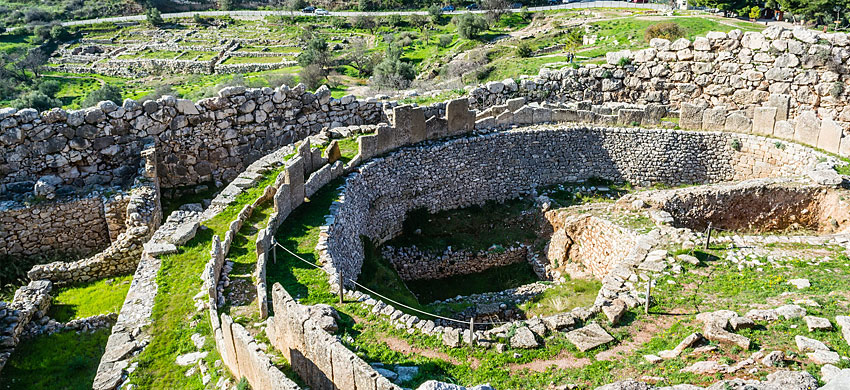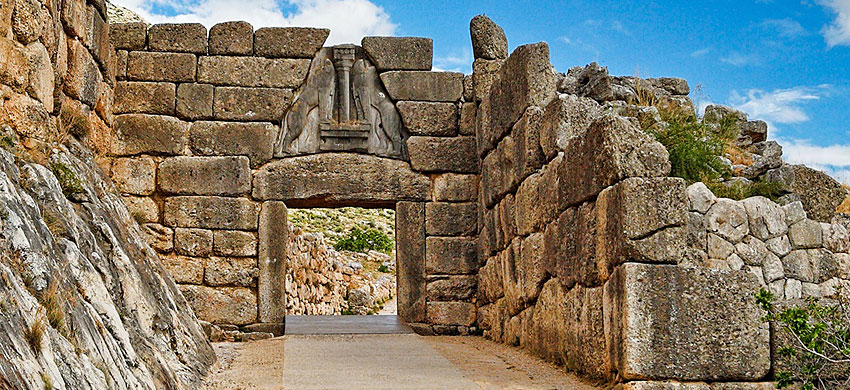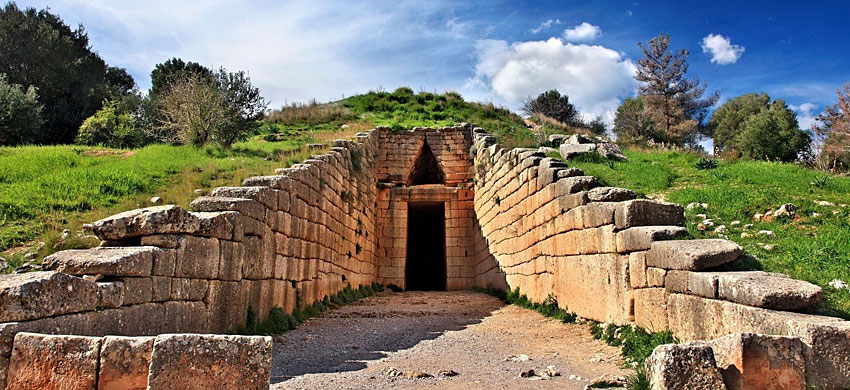

Hidden among the barren hills of Argolis lies one of Greece’s most precious treasures: the ruins of Mycenae, one of the richest and most influential city-states of the ancient world.
Its period of maximum splendor lasted 400 years, from 1600 to 1200 BC, during which time the city was so important that it gave its name to an entire era – the Mycenaean period – and to a culture. A civilization of traders, navigators and warriors who succeeded in subtracting from the Minoans the supremacy in the Mediterranean.
The name of Mycenae is inextricably linked to that of its most famous king: Agamemnon, supreme leader of all the Greeks in the Trojan War, whose deeds were made immortal by Homer in the Iliad.
We owe the discovery of the ruins of Mycenae at the end of the nineteenth century to the operatic poems: after reading them with passion, the German archaeologist Heinrich Schliemann, already known for the discovery of the city of Troy, set out in search of the “Mycenae rich in gold” mentioned by Homer.
Today you too can experience the thrill of crossing the imposing door that marks the entrance to one of the cities that have made the history of mankind and walk along paths and alleys once traveled by kings, warriors, maids.
The attractions of Mycenae are basically two: the archaeological park with the ruins of ancient Mycenae and the archaeological museum.

The symbol of Mycenae is the Lion’s Gate, the majestic entrance to the city. The gate, more than three meters high, is topped by a monolith decorated with two lions facing each other on either side of a column. It is almost certain that the column was used to hold up a statuette, but it has not been possible to define its subject. Did it depict the most powerful man in the city? A sacred animal? A divinity? The answer remains shrouded in mystery and contributes to making the entrance to the ancient city even more suggestive.
As you cross the threshold, try to imagine yourself as the archaeologist Schliemann entering the mythical city of Mycenae for the first time.
The Lion’s Gate opens along the wall complex that protected the ancient city, known as the Cyclopean Walls due to its enormous size (thickness ranging from 3 to a good 8 meters!). According to legend, the construction of such imposing walls was only possible with the help of a Cyclops, the giants with one eye in Homeric tradition.
Past the Lion’s Gate climbing up narrow paths and stairs you can reach the royal palace of Agamemnon and see the remains of the private rooms of one of the most famous kings of ancient Greece, the same in which he was probably murdered.

Another unmissable stop on a visit to ancient Mycenae is the Treasury of Atreus, also known as the Tomb of Agamemnon. It is a circular construction where a member of a royal family was certainly buried, but it has never been proven that it was actually Agamemnon. Again, the mystery adds to the charm of the place.
Six other circular tombs have been discovered in the area, with the remains of 19 people, known as the Tombs of the Kings. Among them is also the Tomb of Clytemnestra, wife of Agamemnon.

At the foot of the ancient citadel there is the Archaeological Museum of Mycenae, interesting to visit before or after the historical ruins in order to better understand the importance of this city in the ancient world and the refinement of the Mycenaean civilization.
A photographic exhibition traces the history of the excavations that brought this fascinating treasure back to life while a collection of over 2500 artifacts will introduce you to the Mycenaean civilization in all its facets.
Some of the most beautiful works of art and craftsmanship found in the excavations of Mycenae, such as the famous Mask of Agamemnon, can be admired at the Archaeological Museum of Athens.
There are no hotels in the immediate vicinity of the archaeological park of Mycenae. The majority of tourists book a hotels in Nauplia, where instead the hotel offer is quite varied, with proposals for all budgets ranging from cheap family run pensions to luxury hotels with swimming pool.
Locality closer to Mycenae are Argos and Ireo, where, however, prevail accommodations in the category of medium-low price: they are therefore recommended to those who travel low cost and not to those looking for something exclusive.
The best way to reach Mycenae is with a rented car. From Athens take the highway to Corinth and continue towards Tripoli for about 25 km until you meet the junction to Nafplio. Continue straight until you meet the exit for Mycenae. The duration of the trip is about two hours.
If you prefer to travel by public transportation, you can take a bus from Athens in the direction of Nafplio, which runs approximately every hour. The duration of the trip is about two hours, but from the stop to reach the archaeological park you’ll have to take a local bus or walk a bit.
Another possibility is to visit Mycenae with a guided tour departing from Athens. You can choose between several proposals: the classic itineraries include a stop in all the most famous places of Argolis as Epidaurus and Nafplio or you can combine the visit of Mycenae to a boat tour of the Corinth Canal.
The city of Mycenae is located in Argolis, a Greek region in the Peloponnese peninsula, at a distance of about 130 km southeast from Athens and about 20 km from Nafplio (the regional capital, it is also called Napflio). The sea is about 30 kilometers away.